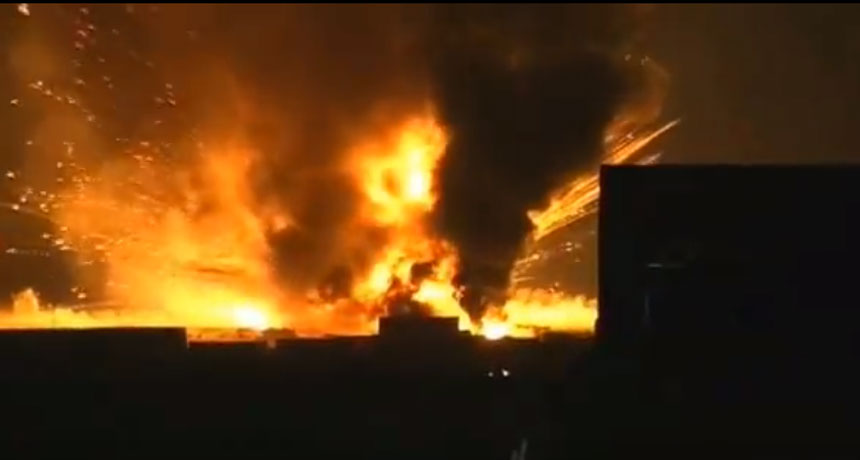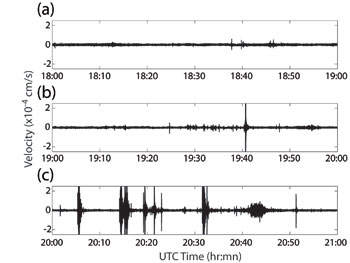Tracking warfare by ‘Earth shakes’
Seismologists have discovered that every major military weapon gives off its own quaking signature

The ammunitions depot at the U.S. Air Force Forward Operating Base Falcon was destroyed by enemy mortars on October 10, 2006. Explosions at the time sent off clear seismic signals.
Taylor Creasman/YouTube
By Beth Geiger
When Michael Wysession says his research is a blast, he isn’t kidding. Wysession is a geophysicist at Washington University at St. Louis, Missouri. He is interested in how to track the booms and blasts of a war zone. And he can now do it from a great distance.
Geophysicists use seismographs (SYZE-moh-grafs) — also called seismometers — to detect seismic waves. These waves are pulses of energy that travel through the Earth. Typically, seismographs ‘listen’ for earthquakes. But the devices may detect anything that shakes the ground, or even the air. For instance, seismographs detected the nuclear weapon tested by the North Korean government on January 6. A year earlier, those detectors picked up crowds jumping and dancing during a 2015 football-playoff game inside the Seattle Seahawks’ stadium.

Enemy fire
Baghdad was a violent city in 2006. This was the middle of the Iraq War (which ran from 2003 to 2011). The United States had military bases in Baghdad to help restore peace and to establish a stable government. Yet through all of this, the ground rumbled.
On October 10th of that year, a mortar attack struck a U.S. Air Force base just south of the city. The shelling hit a large store of unexploded ammunition. That triggered a “cook-off” of the ordnance, says Wysession. The explosions lasted for hours. “It was like a fireworks factory exploding,” he says.
Ghassan Aleqabi helped install the seismograph in Baghdad. He works with Wysession at Washington University. In 2014, the two researchers were studying data from that seismograph when they noticed it had recorded the 2006 cook-off. Its data matched, minute by minute, what news accounts of the explosions had claimed.
The military has used seismographs to detect artillery before. Primitive sound-wave analogs proved vital to the Allied defeat of the Germans in World War I. “What was unusual was to be so close,” says Wysession. “We just happened to have that one seismometer four miles from the ammunition depot.” The device had picked up explosive action on other days as well. For instance, the seismic-wave detector picked up an intense attack in Baghdad in December 2006.
Being so close, the seismograph recorded the explosions in fine detail. The researchers looked at how fast the waves moved, or wave frequency. Frequency is measured in hertz, with one hertz equaling one wavelength per second. They also looked at wave intensity, or amplitude. They even studied seismic patterns, to find out if sets of waves were alike or instead contained a random mix of frequencies and amplitudes.
The team’s findings will appear in the February 2016 Bulletin of the Seismological Society of America.
Seismic signatures
Each type of weapon has its own seismic signature, the researchers found. “It’s like listening to sound. A clarinet sounds different from an oboe,” explains Wysession.
Mortar fires create relatively high frequency waves, ones up to 10 hertz. That is followed by lower frequency signals of about 5 hertz. Those mark when a mortar bomb explodes. Meanwhile, frequent, repetitive peaks of the same frequency mean that the source is likely gunfire from a rifle. Car bombs — called vehicle-borne improvised explosive devices — are packed with a mix of explosive types. That gives them complicated seismic signals. Fighter jets, helicopters and drones create rhythmic patterns typical of spinning engines. And when something explodes near buildings, energy echoes off of those structures. That makes the seismic signal more complex than explosions out in the open.
“It’s really amazing what can be recorded with modern seismometers,” said Keith Koper. He is a geophysicist at the University of Utah in Salt Lake City. He was not involved in the new study. “The observations described here,” he predicts, “will provide a kind of library that can be used to help identify the origin of future seismic signals observed near battlefields.”
Modern warfare often consists of small attacks in populated areas, Wysession says. This style of battle uses a variety of weapons — bullets, helicopters, mortars, drones and car bombs.
In Baghdad, only one seismometer was available to record the action. But with an entire array of seismometers it would be possible to triangulate the waves, notes Wysession. This could pinpoint the source of incoming missiles or bullets. And that would be especially useful in urban warfare or at night, where it can be difficult to find the source of many small sources of artillery.
“If we had had a monitored array in Baghdad [back in 2006], we could have identified that these were mortars being fired, identified the location, and intercepted them before the Air Force ammo depot was destroyed,” Wysession told Science News for Students. In other words, he says of the ammo cook-off: “This could have been prevented.”
Power Words
(for more about Power Words, click here)
amplitude A measure of the height of a recurring wave in some signal, water or beam of radiation. In sound, wave amplitude corresponds with intensity — loudness or softness.
array A broad and organized group of objects. Sometimes they are instruments placed in a systematic fashion to collect information in a coordinated way. Other times, an array can refer to things that are laid out or displayed in a way that can make a broad range of related things, such as colors, visible at once.
artillery Large caliber land-based guns used in fighting wars; or the military crews assigned to fire these weapons.
drone A pilotless aircraft or missile flown autonomously or by remote control.
geophysics The branch of science that deals with the physical properties of the Earth. It uses the principles and laws of physics to interpret the internal internal structure, magnetic and gravitational fields, climate, atmosphere, oceans, sea ice and land forms. People who work in this field are known as geophysicists. They study Earth’s features by measuring seismic (acoustic), gravitational, electrical and magnetic properties.
hertz Unit of measurement for wavelengths. One hertz equals one wave per second
military Related to armed forces such as an army or a navy.
mortar A weapon that fires relatively slow moving, explosive bombs at short ranges. Mortars are generally small enough to be moved without a vehicle. The explosive devices they shoot are called mortar bombs.
ordnance Military supplies, chiefly weapons and ammunition, but sometimes also the vehicles used to move weapons and maintenance supplies.
seismic Adjective for something having to do with the ground movements associated with earthquakes.
seismic wave A wave in the ground produced by an earthquake or other means.
seismometer Also known as a seismograph, this is an instrument that detects and measures tremors (known as seismic waves) as they pass through Earth.
triangulate In surveying, to determine the location of something by calculating its position from two or more positions
wave A disturbance or variation that travels through space and matter in a regular, oscillating fashion.
wavelength The distance between one peak and the next in a series of waves, or the distance between one trough and the next.
World War I Also known as WWI and the Great War. This war began in 1914, as two alliances faced off against one another. On one side were the so-called Central Powers — Germany, Bulgaria and the Ottoman and Austro-Hungarian empires. On the other side were the Allies — France, Great Britain, Russia, Italy and, beginning in 1917, the United States.







